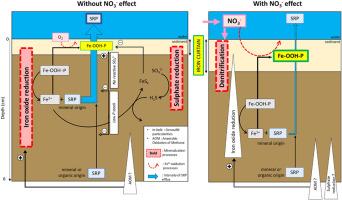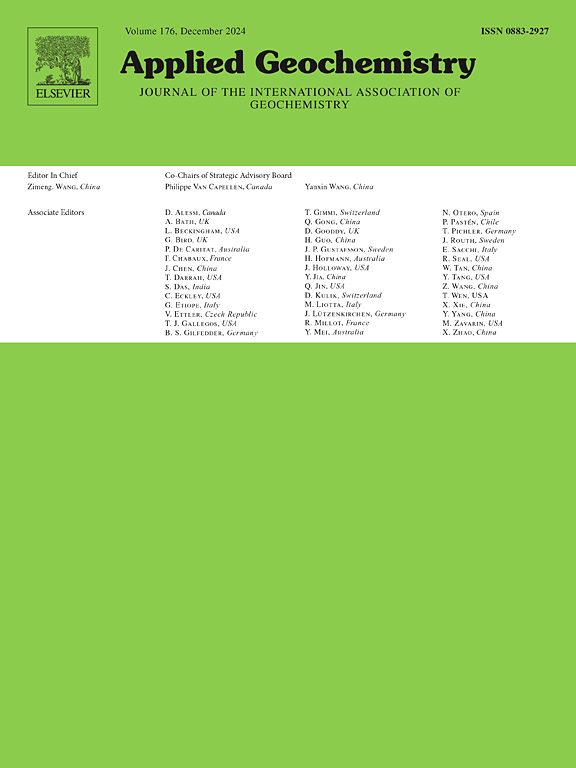P 有限淡水排水沼泽(法国滨海夏朗德省)的沉积地球化学:磷迁移的原始驱动力
IF 3.1
3区 地球科学
Q1 GEOCHEMISTRY & GEOPHYSICS
引用次数: 0
摘要
磷的生物利用率是水生环境中的一个主要问题,它通常会限制水生环境中的初级生产。在这项工作中,我们在 2020 年 2 月至 2021 年 4 月的 9 个月监测期内,对两个排水沼泽(法国马朗和热努瓦耶)的孔隙水和沉积物固相进行了分析,这两个沼泽的用途和管理工具各不相同。沉积物中可溶性活性磷(SRP)的富集受氧化铁溶解的密切控制。后者似乎受到季节性硝酸盐输入(冬季和早春)的高度控制,而季节性硝酸盐输入有利于反硝化作用,反硝化作用是促进铁幕发展和稳定的主要底栖矿化过程。底栖硝酸盐缓解后,其他厌氧代谢也随之发展,如铁溶解还原促进了磷的循环和浮游生物利用率。令人惊讶的是,硫循环似乎影响了磷的动态变化,尤其是在没有硝酸盐的情况下。在马兰斯和热努瓦雷,没有氮氧化物时,硫酸盐在前两厘米深度的还原率较高,分别在 8 月和 7 月达到 -8.9 E-03 ± 0.5 E-03 和 -5.0 E-03 ± 0.2 E-03 nmol cm-3 s-1。这些数值表明,该过程的速率高于反硝化过程(5 月在马兰的最大值为 -5.0 E-03 ± 1.1 E-03 nmol cm-3 s-1)和还原铁生成过程(7 月在热努耶的最大值为 0.5 E-03 ± 0.1 E-03 nmol cm-3 s-1)。过程变化之快(每月一次)证明了这些系统的动态性。这两个地点 NO3-压力地球化学模式的相似性,突出了沿岸系统中扩散污染对氮减缓和磷捕集的重要性。本研究的结果可以为农业压力较大的温带系统建立一个通用的成因运行模式。这样就能有针对性地进行管理,既优化净化功能,又限制这些系统的富营养化风险。本文章由计算机程序翻译,如有差异,请以英文原文为准。

Sedimentary geochemistry in P-limited freshwater drained marshes (Charente-Maritime, France): Original drivers for phosphorus mobilization
Phosphorus bioavailability is a major issue in aquatic environments, where it generally limits primary production. In this work, the analysis of the pore water and the solid phase of the sediment was carried out over a 9-month monitoring period between February 2020 and April 2021 in two drained marshes (Marans and Genouillé, France) distinct by their uses and management tools. Soluble reactive phosphorus (SRP) enrichment in the sediment was intimately controlled by iron oxide dissolution. The latter seemed highly controlled by seasonal nitrate inputs (winter and early spring) that favoured denitrification as a major benthic mineralization process promoting iron curtain development and stability. Following benthic mitigation of nitrate other anaerobic metabolisms developed such as iron dissolutive reduction promoting P recycling and planktic bioavailability. Surprisingly, sulphur cycle seemed to affect P dynamics, especially in the absence of nitrate. The absence of NO3− triggered high sulphate reduction rates in the two first centimeters depth, reaching −8.9 E−03 ± 0.5 E−03 and -5.0 E−03 ± 0.2 E−03 nmol cm−3 s−1 in August and July at Marans and Genouillé respectively. These values placed this process at higher rates than the denitrification (maximum in May at Marans with −5.0 E−03 ± 1.1 E−03 nmol cm−3 s−1) and reduced iron production (maximum in July at Genouillé with 0.5 E−03 ± 0.1 E−03 nmol cm−3 s−1). The rapidity with which process changes occur (monthly scale) testified to the dynamism of these systems. The similarity in geochemical patterns regarding NO3− pressure at both sites underlines the importance of diffuse pollution in coastal systems for nitrogen mitigation and phosphorus trapping. The results obtained in this study could lead to the development of a generalized diagenetic operating model for temperate systems with high agricultural pressure. This would enable to target management efforts to both optimize the purification function and limit eutrophication risks in these systems.
求助全文
通过发布文献求助,成功后即可免费获取论文全文。
去求助
来源期刊

Applied Geochemistry
地学-地球化学与地球物理
CiteScore
6.10
自引率
8.80%
发文量
272
审稿时长
65 days
期刊介绍:
Applied Geochemistry is an international journal devoted to publication of original research papers, rapid research communications and selected review papers in geochemistry and urban geochemistry which have some practical application to an aspect of human endeavour, such as the preservation of the environment, health, waste disposal and the search for resources. Papers on applications of inorganic, organic and isotope geochemistry and geochemical processes are therefore welcome provided they meet the main criterion. Spatial and temporal monitoring case studies are only of interest to our international readership if they present new ideas of broad application.
Topics covered include: (1) Environmental geochemistry (including natural and anthropogenic aspects, and protection and remediation strategies); (2) Hydrogeochemistry (surface and groundwater); (3) Medical (urban) geochemistry; (4) The search for energy resources (in particular unconventional oil and gas or emerging metal resources); (5) Energy exploitation (in particular geothermal energy and CCS); (6) Upgrading of energy and mineral resources where there is a direct geochemical application; and (7) Waste disposal, including nuclear waste disposal.
 求助内容:
求助内容: 应助结果提醒方式:
应助结果提醒方式:


